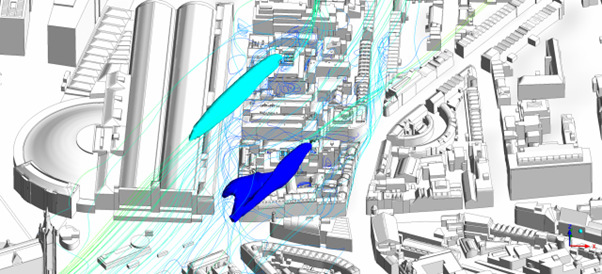Insights
Air Quality - Investment in the Science & Research sector: Part 2.
Modelling the unknown.
Laboratory spaces require a degree of flexibility for a range of reasons. Understanding what processes are being carried out as well as what products – and how much – are being used, is important to assess the impacts of a laboratories’ operation accurately.
Assessing the unknown.
Modelling unknown emissions can be challenging and it often relies on the expertise of consultants and engineers. To understand the intricacy of plume dispersion and how to select the most adequate mitigation measures, it is essential to apply a multi-disciplinary approach.
Providing insight on how early consideration of air quality can bring benefits to the design, via a more rounded and holistic approach, is crucial to identify any opportunities for improvements.
This ensures that air quality is integrated across all stages and disciplines with the aim of promoting the role of air quality in providing a truly optimised design – benefiting the individuals based within the buildings and those in the surrounding environment.
Early air quality integration in early design is key to providing an optimised design considering the wellbeing of individuals and the surrounding environment.
A routine approach…
Design inputs for elements such as fume cupboards can be provided based on the outline of minimum requirements. This advice helps to inform the design team on how to achieve suitable dispersion when detailed information on emissions is not available.
There might be project-specific factors that require further input in the form of evidence on how chemical exhausts will travel from the point of release to sensitive locations. In such cases other tools can be brought to bear in order to improve understanding – this includes Computational Fluid Dynamics (CFD) studies to investigate how chemicals disperse into the atmosphere.
The Future.
Air quality has an elevated importance in the Science and Research sector by the nature of the specialist activities being undertaken – with sensitive uses combined with the use of potential toxic levels of chemicals.
Air quality is a critical component of all our buildings, indoor spaces, and outdoor environments.
It is essential that each project is dealt with separately and a one size fits all approach is not taken due to the variable nature of laboratory spaces, building designs, client aspirations, surrounding receptors and outdoor air quality. Early air quality input and engagement via an integrated approach that is brought to bear with a range of tools and experienced expertise is crucial for the delivery of a robust design that is human-centric and planet-conscious

Figure 1 Example of streamlines visualisation in CFD

Figure 2 Example of plume dispersion visualisation in CFD